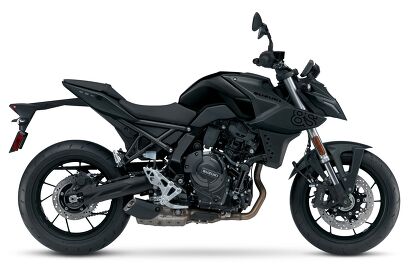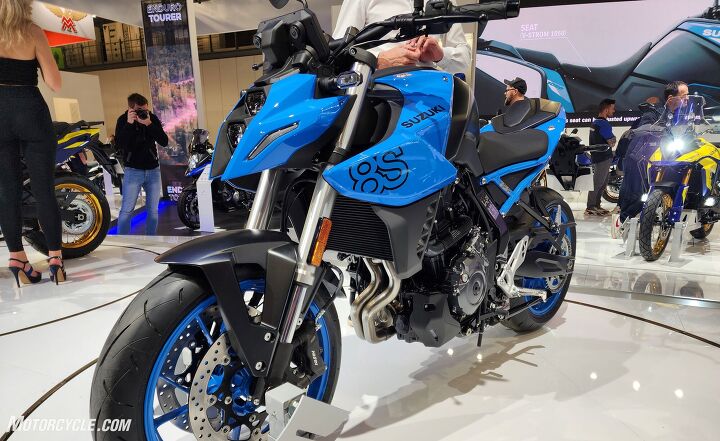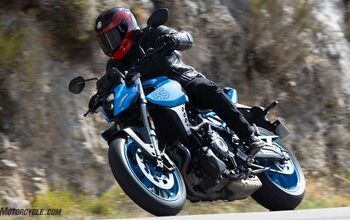2023 Suzuki GSX-8S First Look

Suzuki's all-new platform is a sign of things to come.
At long last, the spiritual successor to Suzuki’s wildly popular SV650 (but not the actual successor, the SV is still staying in the Suzuki lineup) is finally here. Say hello to the GSX-8S, a motorcycle Suzuki says was “engineered from the ground up as an innovative path for future Suzuki sportbikes…”
While we all process what that means for Suzuki’s future, let’s delve into the present day and take a closer look at Suzuki’s new middleweight naked bike. Unlike a lot of Suzuki’s lineup over the past few years (decades?), the GSX-8S is an all-new, ground-up design that some might argue is what the Gladius should have looked like all along. But I digress. Styling-wise, Suzuki’s design team operated on three key terms: “New Era,” “Visual Structure,” and “Icon.” We’ll leave it up to you to decide whether the team succeeded. What we can tell is that the angular and forward-focused design is fresh and modern and should appeal to many riders. The stacked LED lighting is compact and ties in with the rest of the bike’s sharp edges.
Apart from the fact this platform is the starting point for many future Suzuki models to come, the other major talking point is the engine. No longer is Suzuki borrowing from decades-old engines of past models that have struck gold; the 776cc DOHC parallel-Twin in the GSX-8S is all-new and aimed at riders “who desire more power than a 650cc engine can deliver.” Way to throw the SV650 under the bus…
Parallel-Twins are the popular orientation for two-cylinder engines these days as their compact nature frees up space for chassis design, and while some (myself included) aren’t fans of the typical parallel-Twin sound, this new engine uses a 270-degree firing order (like the Yamaha CP2 engines) for a V-Twin like sound and strong torque production. The spacing of the firing order also helps with linear power delivery the rider can feel at the right grip.
The downside of offset firing orders, however, is inherent vibration. Suzuki’s patented Cross Balancer technology – used for the first time on a production motorcycle – employs two counterbalancers at 90º to the crankshaft to keep buzz to a minimum. To quote Suzuki:
Balancer No.1 cancels the primary vibration generated by the piston (reciprocating weight) of the first cylinder, while balancer No.2 cancels the primary vibration of the second cylinder. Adopting a 270-degree crankshaft angle cancels secondary vibration, contributing to even smoother engine operation. Furthermore, placing the two balancers at 90° to the crankshaft with each positioned equidistant from the crankshaft cancels primary couple vibration, further smoothing power delivery.
The plated cylinders measure 84mm (stroke is 70mm) and are fed air through two electronic 42mm throttle bodies. Two ten-hole, long-nose, 49 PSI injectors feed pressurized and atomized fuel to the combustion chamber. Interestingly, the 6.0-liter airbox and its intake funnels sit underneath the seat (instead of under the fuel tank or closer towards the path of incoming air) to help keep overall chassis dimensions as svelte as possible. Something tells us aftermarket tuners will have a headache trying to improve upon that design.
Shifting is made easy thanks to Suzuki’s bi-directional Quick Shift system, which, if it’s identical to the one used on the current GSX-S1000GT, is one of the best systems on the market and will greatly add to the 8S’ riding enjoyment.
The new engine is mounted in a new steel frame with an aluminum swingarm. Suspension duties are handled by a KYB inverted fork and preload adjustable shock, while Nissin radial-mount calipers are paired with 310mm rotors. ABS and four-level traction control come standard and are tunable with the three different ride modes (traction control can also be turned off).
As of this writing, Suzuki has not yet released an availability timeline or cost, though the latter was of utmost concern. Knowing Suzuki, expect the GSX-8S to be very competitively priced.

Troy's been riding motorcycles and writing about them since 2006, getting his start at Rider Magazine. From there, he moved to Sport Rider Magazine before finally landing at Motorcycle.com in 2011. A lifelong gearhead who didn't fully immerse himself in motorcycles until his teenage years, Troy's interests have always been in technology, performance, and going fast. Naturally, racing was the perfect avenue to combine all three. Troy has been racing nearly as long as he's been riding and has competed at the AMA national level. He's also won multiple club races throughout the country, culminating in a Utah Sport Bike Association championship in 2011. He has been invited as a guest instructor for the Yamaha Champions Riding School, and when he's not out riding, he's either wrenching on bikes or watching MotoGP.
More by Troy Siahaan






























































































































Comments
Join the conversation
I'm a little late here. Now that it's been out for a bit... which do you like better, the SV650 or the GSX-8S?
New Honda CB750 Hornet vs its primary competitor--- Suzuki GSX-8S
The Honda CB750 Hornet is a better bike than the Suzuki GSX-8S --- Better looking front-end, more powerful (+ 9 hp), better handling, much lighter (26 lbs. less), less expensive ($1,000), better for shorter riders (.6" lower seat), larger fuel tank (+ .3 gallons), basic color options, SOHC as opposed to DOHC (see why below), and better reliability (Suzuki is very reliable, but Honda is at top of Big Four).
Benefits of SOHC instead of DOHC (per Honda):
"a single overhead cam, which Honda says gives several advantages over a twin cam: the cylinder head can be lighter and more compact, there’s space for the valves and intake to be more upright and with fewer parts spinning around creating inertia, the handling is improved, too."